2012 MERCEDES-BENZ E-CLASS ESTATE tow
[x] Cancel search: towPage 430 of 457

Removing the emergenc
yspare wheel
(Estate with folding benc hseat) Example: emergency spar
ewheel
X Remove vehicle tool kit tray :by
recess ;.
X Remove the "Minispare" emergency spare
wheel or collapsible emergency spare
wheel =.
For further information on changing and fit-
ting a wheel, see (Y page 389). Stowing
aused collapsible emer-
gency spare wheel
! Only place the collapsible emergency
spare wheel in the vehicle when it is dry.
Otherwise, moisture may get into the vehi-
cle.
Take the following steps to stow a used col-
lapsible emergency spare wheel. It will not
otherwise fit into the spare wheel well.
Mercedes-Benz recommends that you have
this work performed at aqualified specialist
workshop, e.g. at a Mercedes-Ben zService
Centre.
X Unscrew the valve cap from the valve.
X Use the back of the valve cap to unscrew
the valve insert from the valve and release
the air.
i Fully deflating the tyre may take a few
minutes.
X Screw the valve insert back into the valve.
X Screw the valve cap back on. X
Remove the protective film from the vehicle
tool kit and put it over the collapsible emer-
gency spare wheel.
X Stow the collapsible emergency spare
wheel in the emergency spare wheel well
under the boot. Inflating the collapsible emergency
spare wheel
! Inflate the collapsible emergency spare
wheel using the tyre inflation compressor
before lowering the vehicle. The wheel rim
could otherwise be damaged.
! Do not operate the tyre inflation com-
pressor for longer than eight minutes at a
time without a break. It may otherwise
overheat.
The tyre inflation compressor can be oper-
ated again once it has cooled down. X
Mount the collapsible emergency spare
wheel as described (Y page 388).
The collapsible emergency spare wheel
must be mounted before it is inflated.
X Pull connector ?and the air hose out of
the housing.
X Remove the cap from the valve on the col-
lapsible emergency spare wheel.
X Screw union nut :on the air hose onto the
valve.
X Make sure on/off switch Aof the tyre
inflation compressor is set to 0. Emergency spare wheel
427Wheels and tyres Z
Page 431 of 457
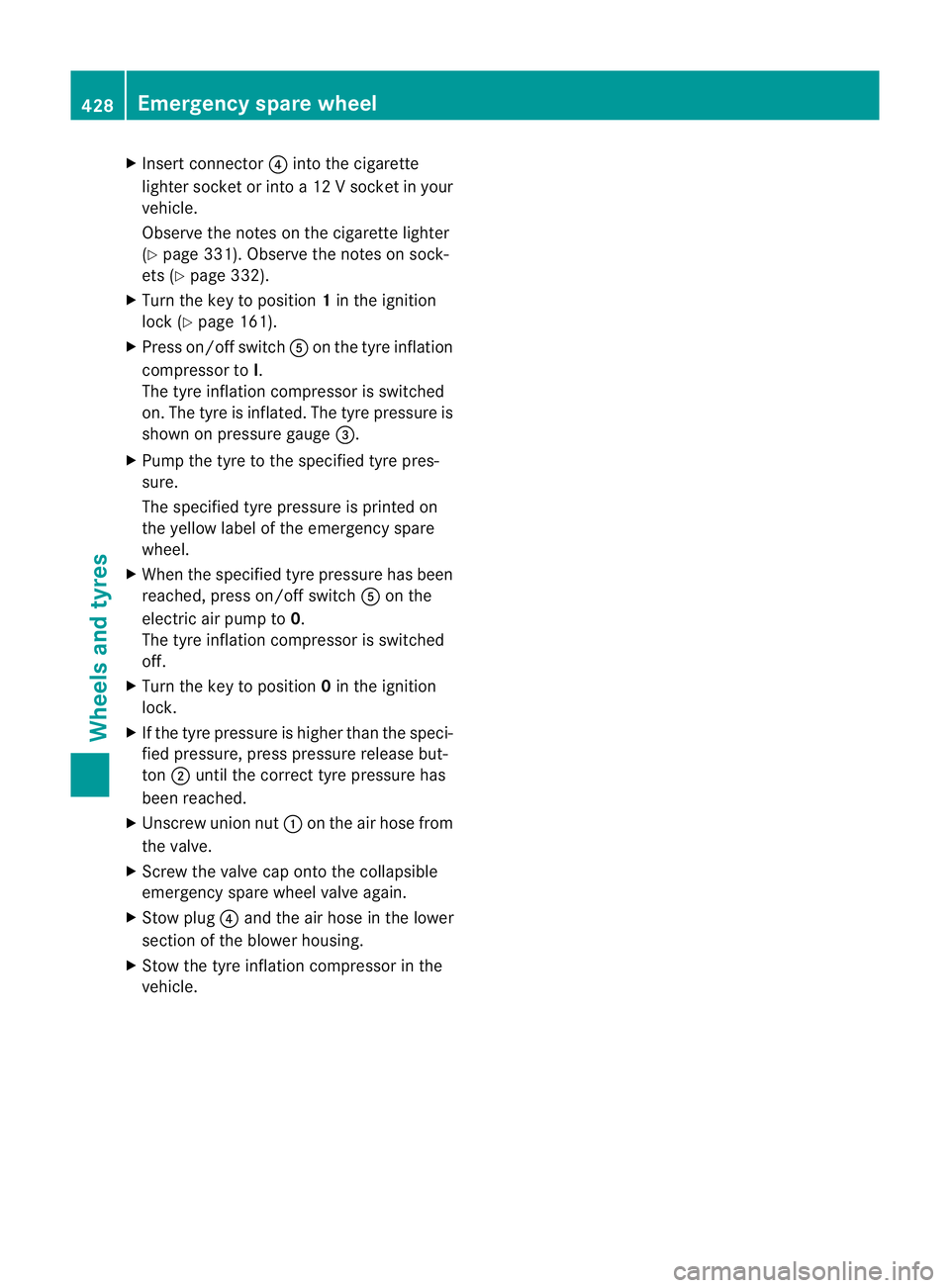
X
Insert connector ?into the cigarette
lighter socket or into a 12 Vsocket in your
vehicle.
Observe the notes on the cigarette lighter
(Y page 331). Observe the notes on sock-
ets (Y page 332).
X Turn the key to position 1in the ignition
lock (Y page 161).
X Press on/offs witchAon the tyre inflation
compressor to I.
The tyre inflatio ncompressor is switched
on. The tyre is inflated. The tyre pressure is
shown on pressure gauge =.
X Pump the tyre to the specified tyre pres-
sure.
The specified tyre pressure is printed on
the yellow label of the emergency spare
wheel.
X When the specified tyre pressure has been
reached, press on/offs witchAon the
electric air pump to 0.
The tyre inflatio ncompressor is switched
off.
X Turn the key to position 0in the ignition
lock.
X If the tyre pressure is higher than the speci-
fied pressure, press pressure release but-
ton ;until the correct tyre pressure has
been reached.
X Unscrew union nut :on the air hose from
the valve.
X Screw the valve cap ontot he collapsible
emergency spare wheel valve again.
X Stow plug ?and the air hose in the lower
section of the blower housing.
X Stow the tyre inflation compressor in the
vehicle. 428
Emergency spare wheelWheels and tyres
Page 434 of 457
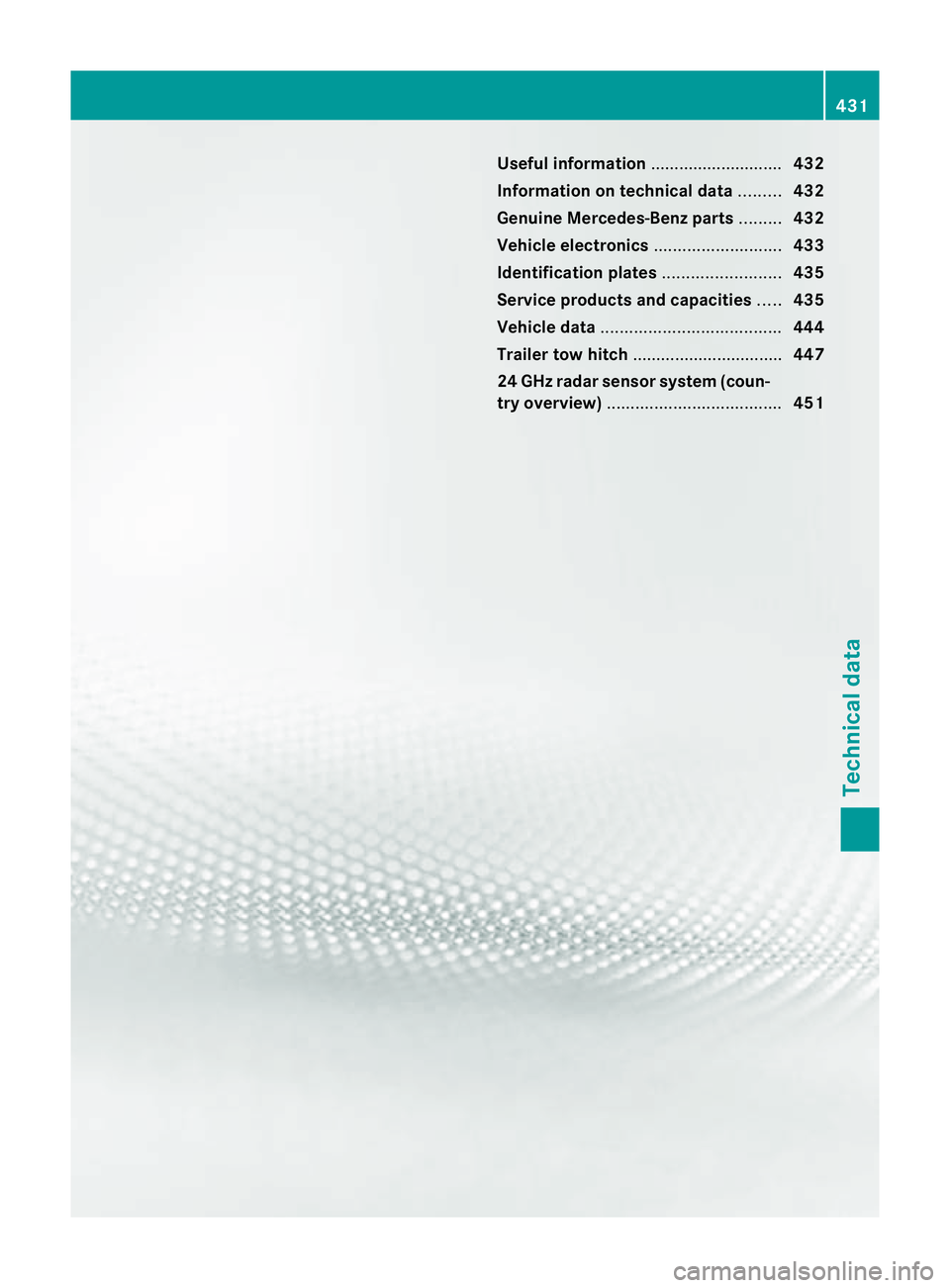
Useful information
............................432
Information on technical data .........432
Genuine Mercedes-Benz parts .........432
Vehicle electronics ...........................433
Identification plates .........................435
Service products and capacities .....435
Vehicle data ...................................... 444
Trailer tow hitch ................................ 447
24 GHz radar sensor system (coun-
tryo verview) ..................................... 451 431Technical data
Page 442 of 457

a high sulphur conten
tis available, you will
need to carry out your vehicle's oil change
at shorter intervals. More information
aboutt he interval for oil change can be
obtained from any qualified specialist
workshop.
Usually you will find information about the
fuel grade on the pump. If you cannot find the
label on the petrol pump, ask the filling sta-
tion staff.
Information on refuelling (Y page 180).
Low outside temperatures
In winter months, diesel fuel with an improved
cold flow quality is available. In Europe, the
EN 590 standard defines various climate-
dependent temperature categories. Malfunc-
tions can be avoided by refuelling with diesel
fuel that corresponds to the climatic specifi-
cations outlined in EN 590. At unusually low
outside temperatures, it is possible that the
flow characteristics of the diesel fuel could be
insufficient .Accordingly, diesel fuel from
warmer areas may not be suitable for opera-
tion in colder climati cconditions.
i Further information on country-specific
fuel properties can be obtained from oil
companies, e.g. at filling stations.
Flow improvers
To improve the low-temperature resistance of
diesel fuel, a flow improver can be attached.
The effectiveness of a flow improver is not
guaranteed for every fuel.
Only use flow improvers tested and approved
by Mercedes-Benz. During use, please
observe the information on operation.
Correct dosage and sufficient mixing are deci-
sive in improving low-temperature resistance
with the flow improver. Overdosage can
potentially even decrease low-temperature
resistance and must therefore be avoided.
Follow the manufacturer's guidelines on dos-
age.
Mix the additive into the diesel in good time,
before the flow characteristics of the diesel become insufficient. Otherwise, malfunctions
can arise through heating the fuel system,
e.g. through parking in a heated garage.
More information about recommended flow
improvers can be obtained from any qualified
specialist workshop.
Fuel consumption information
H
Environmental note
CO 2(carbon dioxide) is the gas which scien-
tists believe to be principally responsible for
global warming (the greenhouse effect). Your
vehicle's CO 2emissions are directly related to
fuel consumption and therefore depend on:
R efficient use of the fuel by the engine
R driving style
R other non-technical factors, such as envi-
ronmental influences or road conditions
You can minimise your vehicle's CO 2emis-
sions by driving carefully and having it serv-
iced regularly.
The vehicle will use more fuel than usual in
the following situations:
R at very low outside temperatures
R in urban traffic
R on short journeys
R in mountainous terrain
R when towing a trailer
i Only for certain countries: you can find
the current consumption and emission val-
ues of your vehicle in the COC documents
(EU CERTIFICATE OF CONFORMITY). These
documents are delivered with your vehicle.
The consumption figures were in each case
based on the currently applicable version:
R for vehicles that comply with standards
up to and including the EURO 4standard,
in accordance with EU Directive
80/1268/EEC
R for vehicles tha tcomply with or exceed
the EURO 5standard, in accordance with
Regulation (EC )No. 715/2007 Service products and capacities
439Technical data Z
Page 450 of 457

E 350 CDI BlueEFFI-
CIENCY
Vehicle height, Saloon
1472 mm
Vehicle height, Estate
1515 mm
Unladen weight
,Saloon 1845 kg
Unladen weight, Estate
1955 kg
E 350 CDI 4MATIC BlueEF-
FICIENCY
Vehicle height, Saloon
1474 mm
Vehicle height, Estate
1517 mm
Unladen weight, Saloon
1900 kg
Unladen weight, Estate
2010 kg
E 350 BlueTEC
Vehicle height, Saloon
1472 mm
Vehicle height, Estate
1515 mm
Unladen weight, Saloon
1845 kg
Unladen weight, Estate
1955 kg
Trailer tow hitch
Mounting dimensions
! If you have a trailer tow hitch retrofitted,
changes to the cooling system may be nec-
essary, depending on the vehicle type.
If you have a trailer tow hitch retrofitted,
observe the anchorage points on the chas-
sis frame. Example: anchorage points for the trailer tow hitch
:
Anchorage points
; Overhang dimension
= Rea raxle centre line
For traile rtow hitches fitted at the factory, the
overhang dimension including protective cov-
ering is 1253 mm (Saloon) or 1278 mm
(Estate). Trailer tow hitch
447Technical data Z
Page 451 of 457
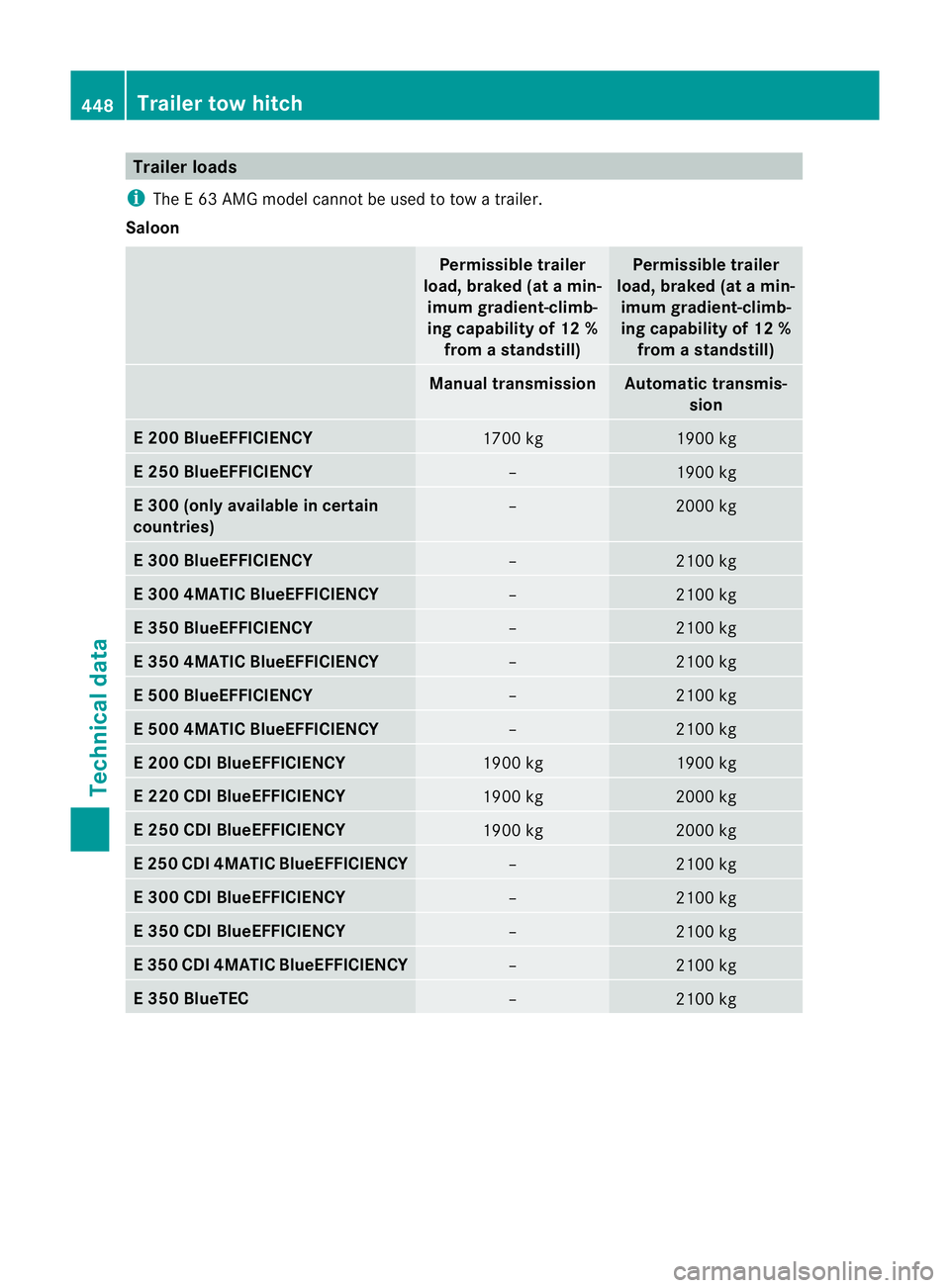
Trailer loads
i The E63A MG model cannot be used to tow a trailer.
Saloon Permissible trailer
load, braked (at a min- imum gradient-climb-
ing capability of 12 % from a standstill) Permissible trailer
load, braked (at a min- imum gradient-climb-
ing capability of 12 % from a standstill) Manual transmission Automatic transmis-
sion E 200 BlueEFFICIENCY
1700 kg 1900 kg
E 250 BlueEFFICIENCY
– 1900 kg
E 300 (only available in certain
countries)
– 2000 kg
E 300 BlueEFFICIENCY
– 2100 kg
E 300 4MATIC BlueEFFICIENCY
– 2100 kg
E 350 BlueEFFICIENCY
– 2100 kg
E 350 4MATIC BlueEFFICIENCY
– 2100 kg
E 500 BlueEFFICIENCY
– 2100 kg
E 500 4MATIC BlueEFFICIENCY
– 2100 kg
E 200 CDI BlueEFFICIENCY
1900 kg 1900 kg
E 220 CDI BlueEFFICIENCY
1900 kg 2000 kg
E 250 CDI BlueEFFICIENCY
1900 kg 2000 kg
E 250 CDI 4MATIC BlueEFFICIENCY
– 2100 kg
E 300 CDI BlueEFFICIENCY
– 2100 kg
E 350 CDI BlueEFFICIENCY
– 2100 kg
E 350 CDI 4MATIC BlueEFFICIENCY
– 2100 kg
E 350 BlueTEC
– 2100 kg448
Trailer tow hitchTechnical data
Page 452 of 457
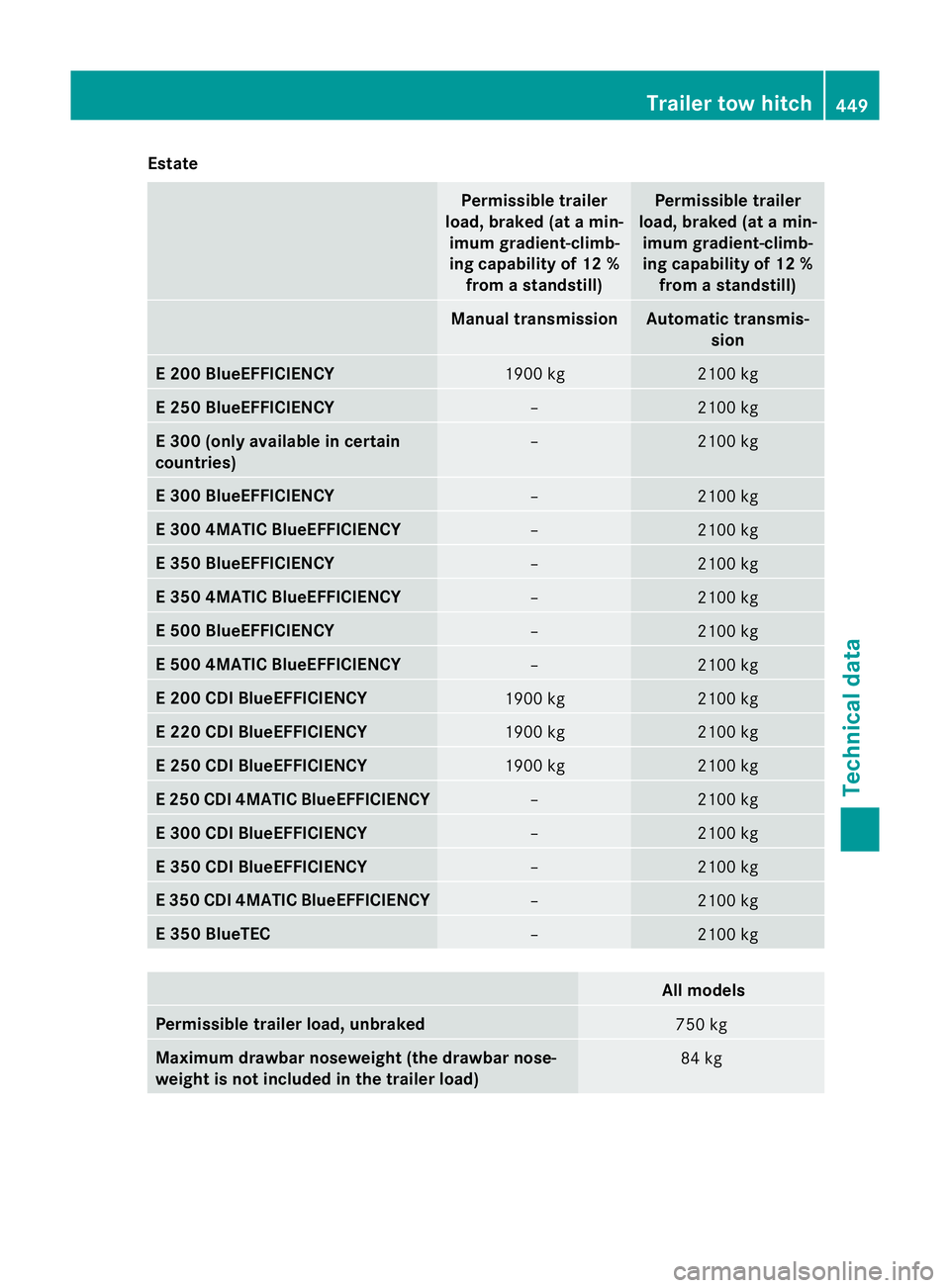
Estate
Permissible trailer
load, braked (at a min- imum gradient-climb-
ing capability of 12 % from a standstill) Permissible trailer
load, braked (at a min- imum gradient-climb-
ing capability of 12 % from a standstill) Manual transmission Automatic transmis-
sion E 200 BlueEFFICIENCY
1900 kg 2100 kg
E 250 BlueEFFICIENCY
– 2100 kg
E 300 (only available in certain
countries)
– 2100 kg
E 300 BlueEFFICIENCY
– 2100 kg
E 300 4MATIC BlueEFFICIENCY
– 2100 kg
E 350 BlueEFFICIENCY
– 2100 kg
E 350 4MATIC BlueEFFICIENCY
– 2100 kg
E 500 BlueEFFICIENCY
– 2100 kg
E 500 4MATIC BlueEFFICIENCY
– 2100 kg
E 200 CDI BlueEFFICIENCY
1900 kg 2100 kg
E 220 CDI BlueEFFICIENCY
1900 kg 2100 kg
E 250 CDI BlueEFFICIENCY
1900 kg 2100 kg
E 250 CDI 4MATIC BlueEFFICIENCY
– 2100 kg
E 300 CDI BlueEFFICIENCY
– 2100 kg
E 350 CDI BlueEFFICIENCY
– 2100 kg
E 350 CDI 4MATIC BlueEFFICIENCY
– 2100 kg
E 350 BlueTEC
– 2100 kg
All models
Permissible trailer load
,unbraked 750 kg
Maximum drawbar noseweight (the drawbar nose-
weight is not included in the trailer load) 84 kgTrailer tow hitch
449Technical data Z
Page 453 of 457
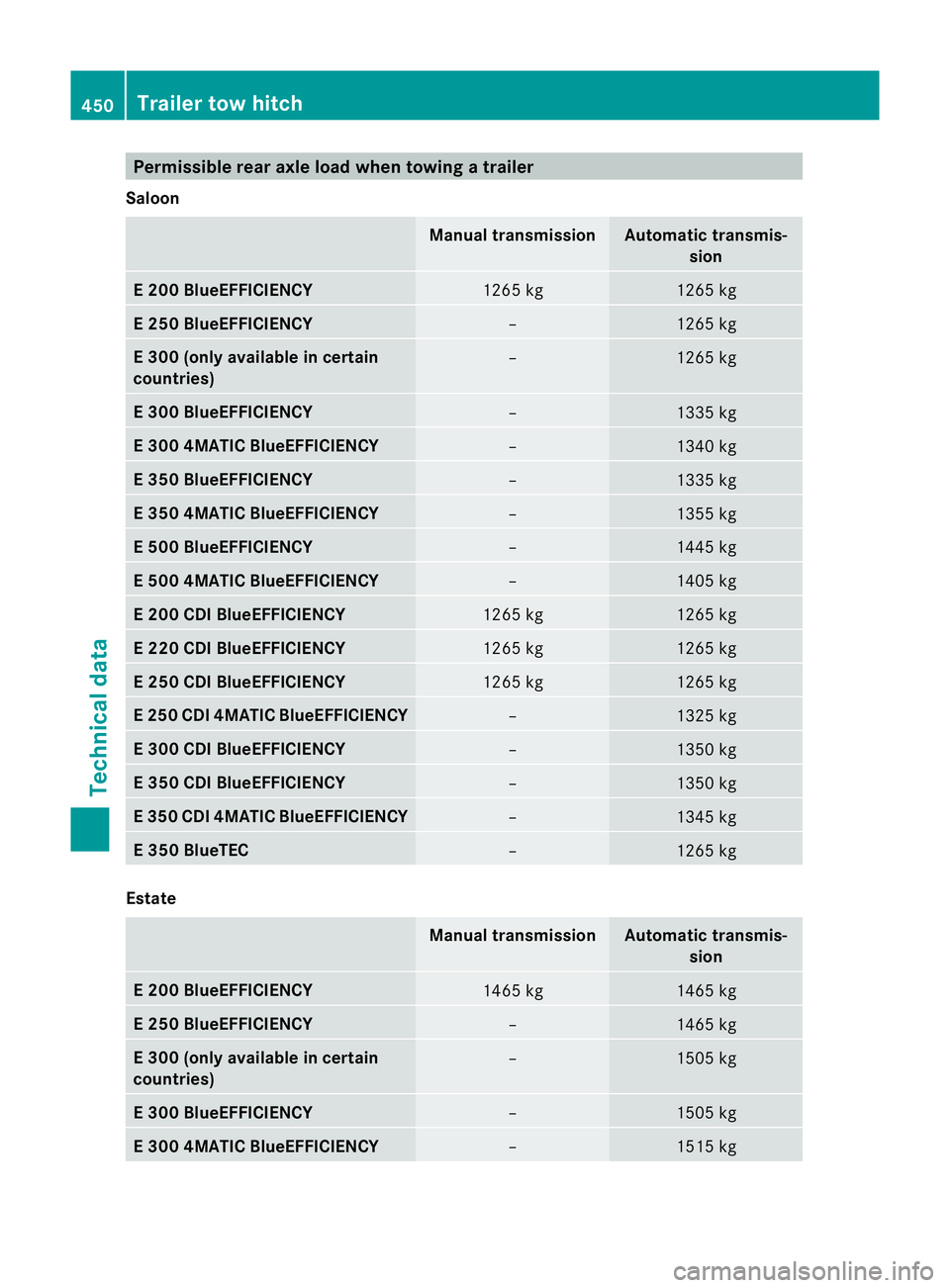
Permissible rear axle load when towing
atrailer
Saloon Manual transmission Automatic transmis-
sion E 200 BlueEFFICIENCY
1265 kg 1265 kg
E 250 BlueEFFICIENCY
– 1265 kg
E 300 (onl
yavailable in certain
countries) – 1265 kg
E 300 BlueEFFICIENCY
– 1335 kg
E 300 4MATIC BlueEFFICIENCY
– 1340 kg
E 350 BlueEFFICIENCY
– 1335 kg
E 350 4MATIC BlueEFFICIENCY
– 1355 kg
E 500 BlueEFFICIENCY
– 1445 kg
E 500 4MATIC BlueEFFICIENCY
– 1405 kg
E 200 CDI BlueEFFICIENCY
1265 kg 1265 kg
E 220 CDI BlueEFFICIENCY
1265 kg 1265 kg
E 250 CDI BlueEFFICIENCY
1265 kg 1265 kg
E 250 CDI 4MATIC BlueEFFICIENCY
– 1325 kg
E 300 CDI BlueEFFICIENCY
– 1350 kg
E 350 CDI BlueEFFICIENCY
– 1350 kg
E 350 CDI 4MATIC BlueEFFICIENCY
– 1345 kg
E 350 BlueTEC
– 1265 kg
Estate
Manual transmission Automatic transmis-
sion E 200 BlueEFFICIENCY
1465 kg 1465 kg
E 250 BlueEFFICIENCY
– 1465 kg
E 300 (only available in certain
countries)
– 1505 kg
E 300 BlueEFFICIENCY
– 1505 kg
E 300 4MATIC BlueEFFICIENCY
– 1515 kg450
Trailer tow hitchTechnical data